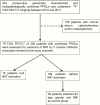Pheochromocytoma and Paraganglioma Patients With Poor Survival Often Show Brown Adipose Tissue Activation
- PMID: 31903484
- PMCID: PMC7059996
- DOI: 10.1210/clinem/dgz314
Pheochromocytoma and Paraganglioma Patients With Poor Survival Often Show Brown Adipose Tissue Activation
Abstract
Context: Pheochromocytomas/paragangliomas (PPGLs) are neuroendocrine tumors that can secrete norepinephrine (NE). Brown adipose tissue (BAT) activation is mediated through the action of NE on β-adrenoceptors (β-ARs). In some malignancies, BAT activation is associated with higher cancer activity.
Objective: To study the relationship between BAT activation and PPGL clinical outcomes.
Design: A retrospective case-control study that included 342 patients with PPGLs who underwent 18F-fluoro-2-deoxy-D-glucose positron emission tomography-computed tomography (18F-FDG PET/CT) imaging at the National Institutes of Health (NIH). We excluded all patients with parasympathetic tumors and those who underwent 18F-FDG PET/CT after PPGL resection. Scans of 205 patients were reviewed by 2 blinded nuclear medicine physicians; 16 patients had BAT activation on 18F-FDG PET/CT [7.80%; age 27.50 (15.00-45.50) years; 10 female/6 male; body mass index [BMI] 24.90 [19.60-25.35] kg/m2). From the remaining 189 patients, we selected 36 matched controls (age 34.4 [25.4-45.5] years; 21 female/15 male; BMI 25.0 [22.0-26.0] kg/m2).
Primary outcome measure: Overall survival.
Results: The presence of active BAT on 18F-FDG PET/CT was associated with decreased overall survival when compared with the control group (HRz 5.80; 95% CI, 1.05-32.05; P = 0.02). This association remained significant after adjusting for the SDHB mutation. Median plasma NE in the BAT group was higher than the control group [4.65 vs 0.55 times above the upper limit of normal; P < 0.01]. There was a significant association between higher plasma NE levels and mortality in PPGLs in both groups.
Conclusions: Our findings suggest that the detection of BAT activity in PPGL patients is associated with higher mortality. We suggest that BAT activation could either be reflecting or contributing to a state of increased host stress that may predict poor outcome in metastatic PPGL.
Keywords: 18F-FDG; PET/CT; brown adipose tissue; cancer; norepinephrine; paraganglioma; pheochromocytoma; succinate dehydrogenase; survival.
Published by Oxford University Press on behalf of the Endocrine Society 2020.
Figures




References
-
- Hadi M, Chen CC, Whatley M, Pacak K, Carrasquillo JA. Brown fat imaging with (18)F-6-fluorodopamine PET/CT, (18)F-FDG PET/CT, and (123)I-MIBG SPECT: a study of patients being evaluated for pheochromocytoma. J Nucl Med. 2007;48(7):1077–1083. - PubMed
-
- Puar T, van Berkel A, Gotthardt M, et al. . Genotype-dependent brown adipose tissue activation in patients with pheochromocytoma and paraganglioma. J Clin Endocrinol Metab. 2016;101(1):224–232. - PubMed

